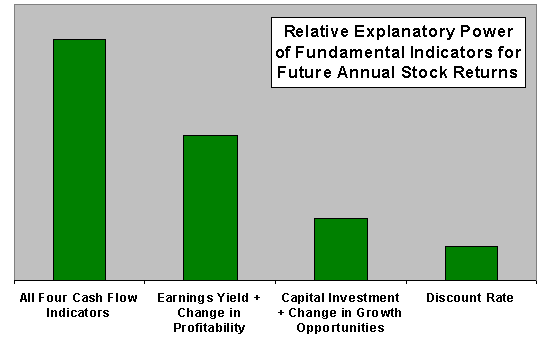Which accounting data is most important in predicting future stock returns? In their July 2006 paper entitled “How Do Accounting Variables Explain Stock Price Movements? Theory and Evidence”, Peter Chen and Guochang Zhang test the predictive power of a model that combines the discount rate with four indicators of company cash flow: (1) earnings yield; (2) capital investment; (3) changes in profitability; and, (4) changes in growth opportunities. Earnings yield indicates current cash flow generation, while the other three factors indicate future changes in cash flow generation. Using annual company-level accounting data and analyst growth forecasts for cash flow indicators (27,897 firm-year observations over the period 1983-2001) and the yield on 10-year Treasury notes for the discount rate, they conclude that:
- All five indicators relate significantly with future stock returns, cash flow indicators positively and the discount rate negatively.
- The model explains 17.4% of the variation in annual stock returns, compared with just 10% for a representative earnings-based model. Cash flow indicators explain much more of this variation than does the discount rate. Among cash flow indicators, earnings yield and change in profitability are more important than capital investment and change in growth opportunities. (See the chart below.)
- The change in profitability and change in growth opportunities become more important indicators for companies with high profitability.
- The qualitative properties of the model hold in subsamples formed on company size, book-to-market, and growth, as well as across different periods.
The following chart, constructed from data in the paper, depicts the relative explanatory power of different combinations of cash flow indicators and the discount rate for future annual stock returns. It shows that including all four cash flow indicators significantly enhances explanatory power, and that most of the power of the cash flow indicators comes from earnings yield and change in profitability. It also shows that the discount rate is relatively unimportant for explaining annual stock returns.

In summary, investors may want to examine a range of accounting indicators, not just earnings and earnings growth rate, to identify stocks likely to outperform over the long term.